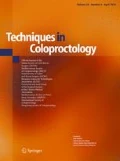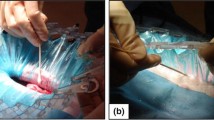Abstract
Background
Surgical site infections (SSI) are costly complications that may cause significant morbidity and increase the cost of care, particularly in colorectal surgery. Microbial sealants (MS) are a new class of wound barriers aimed at decreasing SSI; however, there is only evidence of benefit in clean class 1 procedures. Based on its success in class 1 procedures, we hypothesized that a microbial sealant could reduce the rate of SSI by half for clean-contaminated colorectal procedures (class 2).
Methods
This was a single institution, multihospital, prospective, randomized study approved by the institutional review board. The primary objective was to determine the rate of SSI when microbial sealant (InteguSeal© Kimberly-Clark) is used compared to control (no microbial sealant). Data collected included: open versus laparoscopy, age, body mass index (BMI), diabetes and morbidity [American Society of Anesthesiologists (ASA) class], hospital readmission, reoperation and wound dehiscence. Enrolled subjects received the same preoperative mechanical bowel preparation with oral antibiotics, operative skin preparation (Chloraprep), Surgical Care Improvement Project guidelines implementation), and postoperative care glycemic control for diabetics.
Results
A total of 100 subjects were recruited over 15 months (MS-50; no MS-50). The overall incidence of SSI was 12 %, 14 % (7/50) in the MS versus 10 % (5/50) in the no MS group (p = 0.545). SSI incidence with and without microbial sealant was not significantly different in either the open or the laparoscopic subgroup. Laparoscopy decreased absolute risk of SSI by 16 %. Secondary data (age, BMI, diabetes, ASA) and tertiary data (readmission, reoperation, wound dehiscence) were positively correlated with SSI.
Conclusions
Microbial sealant as employed in this study did not appear to offer any benefit in a class 2 (clean contaminated) operative procedure when perioperative care is standardized. The relative benefit of laparoscopy was also confirmed but unaffected by use of the microbial sealant.
Similar content being viewed by others
References
Raymond DP, Pelletier SJ, Crabtree TD, Schulman AM, Pruett TL, Sawyer RG (2001) Surgical infection and the aging population. Am Surg 67:827–833
de Lissovoy G, Fraeman K, Hutchins V, Murphy D, Song D, Vaughn BB (2009) Surgical site infection: incidence and impact on hospital utilization and treatment costs. Am J Infect Control 37:387–397
Smith RL, Bohl JK, McElearney ST et al (2004) Wound infection after elective colorectal resection. Ann Surg 239:599–605 discussion 605–607
Murray BW, Cipher DJ, Pham T, Anthony T (2011) The impact of surgical site infection on the development of incisional hernia and small bowel obstruction in colorectal surgery. Am J Surg 202:558–560
Cheng KP, Roslani AC, Sehha N et al (2012) ALEXIS O-ring wound retractor vs. conventional wound protection for the prevention of surgical site infections in colorectal resections. Colorectal Dis 14:e346–e351
Webster J, Alghamdi AA (2007) Use of plastic adhesive drapes during surgery for preventing surgical site infection. Cochrane Database Syst Rev 17:CD006353
Kramer A, Assadian O, Lademann J (2010) Prevention of postoperative wound infections by covering the surgical field with iodine-impregnated incision drape (Ioban 2). GMS Krankenhhyg Interdiszip 21:5
Dohmen PM, Gabbieri D, Weymann A, Linneweber J, Geyer T, Konertz W (2011) A retrospective non-randomized study on the impact of INTEGUSEAL, a preoperative microbial skin sealant, on the rate of surgical site infections after cardiac surgery. Int J Infect Dis 15:e395–e400
Iyer A, Gilfillan I, Thakur S, Sharma S (2011) Reduction of surgical site infection using a microbial sealant: a randomized trial. J Thorac Cardiovasc Surg 142:438–442
Dohmen PM, Gabbieri D, Weymann A, Linneweber J, Konertz W (2009) Reduction in surgical site infection in patients treated with microbial sealant prior to coronary artery bypass graft surgery: a case–control study. J Hosp Infect 72:119–126
von Eckardstein AS, Lim CH, Dohmen PM (2011) A randomized trial of a skin sealant to reduce the risk of incision contamination in cardiac surgery. Ann Thorac Surg 92:632–637
Towfigh S, Cheadle WG, Lowry SF, Malangoni MA, Wilson SE (2008) Significant reduction in incidence of wound contamination by skin flora through use of microbial sealant. Arch Surg 143:885–891 discussion 891
Dromzee E, Tribot-Laspière Q, Bachy M, Zakine S, Mary P, Vialle R (2012) Efficacy of integuseal for surgical skin preparation in children and adolescents undergoing scoliosis correction. Spine (Phila Pa 1976) 37:E1331–E1335
Kenny, David A (1987) Statistics for the social and behavioral sciences. Boston. Chapter 13, page 215, in: Little, Brown. ISBN 0-316-48915-8
Rosenberger LH, Politano AD, Sawyer RG (2011) The surgical care improvement project and prevention of post-operative infection, including surgical site infection. Surg Infect (Larchmt) 12:163–168
Adamina M, Kehlet H, Tomlinson GA, Senagore AJ, Delaney CP (2011) Enhanced recovery pathways optimize health outcomes and resource utilization: a meta-analysis of randomized controlled trials in colorectal surgery. Surgery 149:830–840
Horan TC, Gaynes RP, Martone WJ, Jarvis WR, Emori TG (1992) CDC definitions of nosocomial surgical site infections, 1992: a modification of CDC definitions of surgical wound infections. Infect Control Hosp Epidemiol 13:606–608
Hendren S, Fritze D, Banerjee M (2013) Antibiotic choice is independently associated with risk of surgical site infection after colectomy: a population-based cohort study. Ann Surg 257:469–475
Bellows CF, Mills KT, Kelly TN, Gagliardi G (2011) Combination of oral non-absorbable and intravenous antibiotics versus intravenous antibiotics alone in the prevention of surgical site infections after colorectal surgery: a meta-analysis of randomized controlled trials. Tech Coloproctol 15:385–395
Cannon JA, Altom LK, Deierhoi RJ et al (2012) Preoperative oral antibiotics reduce surgical site infection following elective colorectal resections. Dis Colon Rectum 55:1160–1166
Deierhoi RJ, Dawes LG, Vick C, Itani KM, Hawn MT (2013) Choice of intravenous antibiotic prophylaxis for colorectal surgery does matter. J Am Coll Surg 217:763–769
Fry DE (2011) Colon preparation and surgical site infection. Am J Surg 202:225–232
Englesbe MJ, Brooks L, Kubus J (2010) A statewide assessment of surgical site infection following colectomy: the role of oral antibiotics. Ann Surg 252:514–519 discussion 519–520
Krapohl GL, Phillips LR, Campbell DA Jr (2011) Bowel preparation for colectomy and risk of Clostridium difficile infection. Dis Colon Rectum 54:810–817
Darouiche RO, Wall MJ Jr, Itani KM et al (2010) Chlorhexidine-alcohol versus povidone-iodine for surgical-site antisepsis. N Engl J Med 362:18–26
Fujii T, Tabe Y, Yajima R (2011) Effects of subcutaneous drain for the prevention of incisional SSI in high-risk patients undergoing colorectal surgery. Int J Colorectal Dis 26:1151–1155
Sehgal R, Berg A, Figueroa R et al (2011) Risk factors for surgical site infections after colorectal resection in diabetic patients. J Am Coll Surg 212:29–34
Kiran RP, El-Gazzaz GH, Vogel JD, Remzi FH (2010) Laparoscopic approach significantly reduces surgical site infections after colorectal surgery: data from national surgical quality improvement program. J Am Coll Surg 211:232–238
Rea JD, Cone MM, Diggs BS, Deveney KE, Lu KC, Herzig DO (2011) Utilization of laparoscopic colectomy in the United States before and after the clinical outcomes of surgical therapy study group trial. Ann Surg 254:281–288
Conflict of interest
The microbial sealant InteguSeal© was generously provided free of charge by Kimberly-Clark, Inc.
Author information
Authors and Affiliations
Corresponding author
Rights and permissions
About this article
Cite this article
Doorly, M., Choi, J., Floyd, A. et al. Microbial sealants do not decrease surgical site infection for clean-contaminated colorectal procedures. Tech Coloproctol 19, 281–285 (2015). https://doi.org/10.1007/s10151-015-1286-5
Received:
Accepted:
Published:
Issue Date:
DOI: https://doi.org/10.1007/s10151-015-1286-5




